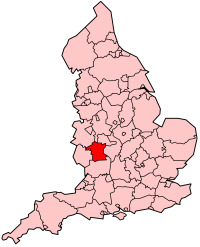Worcestershire



Worcestershire (ˈwʊs.təˌʃə; abbreviated Worcs) is a county in the West Midlands region of central England. From 1974 to 1998 it was part of Hereford and Worcester. The city of Worcester, where the sauce named after Worcestershire was invented, is within this county.
The county borders Herefordshire, Shropshire, Staffordshire, West Midlands, Warwickshire, and Gloucestershire.
Physical geography[change | change source]
Worcestershire is a fairly rural county. The Malvern Hills, which run from the south of the county into Herefordshire, are made up mainly of volcanic rock, some of which date from before 1200 million years ago. For more on the geology of the Malvern Hills, see the other websites section below.
Places of interest[change | change source]
- Avoncroft Museum of Historic Buildings
- Walton Hill and the Clent Hills
- Malvern Hills Area of Outstanding Natural beauty
- Severn Valley Railway
- Worcester Cathedral
- Great Malvern Priory
- Leigh Court Tithe Barn
- Claines Church
- River Teme and valley
- Tenbury Wells with its unique Pump Rooms.
- River Severn at Worcester, River Avon at Pershore or Evesham
- Witley Court at Great Witley. A burnt out shell of a large English stately home, famous for its gigantic fountain, now restored to working order. Currently owned by English Heritage.
- West Midlands Safari Park
- Hanbury Hall
- Forge Mill Needle Museum at Redditch, the only remaining working needle mill in the world.
Local groups[change | change source]
- Worcestershire Conservative Future Archived 2007-07-27 at the Wayback Machine
- Herefordshire and Worcestershire Earth Heritage Trust
